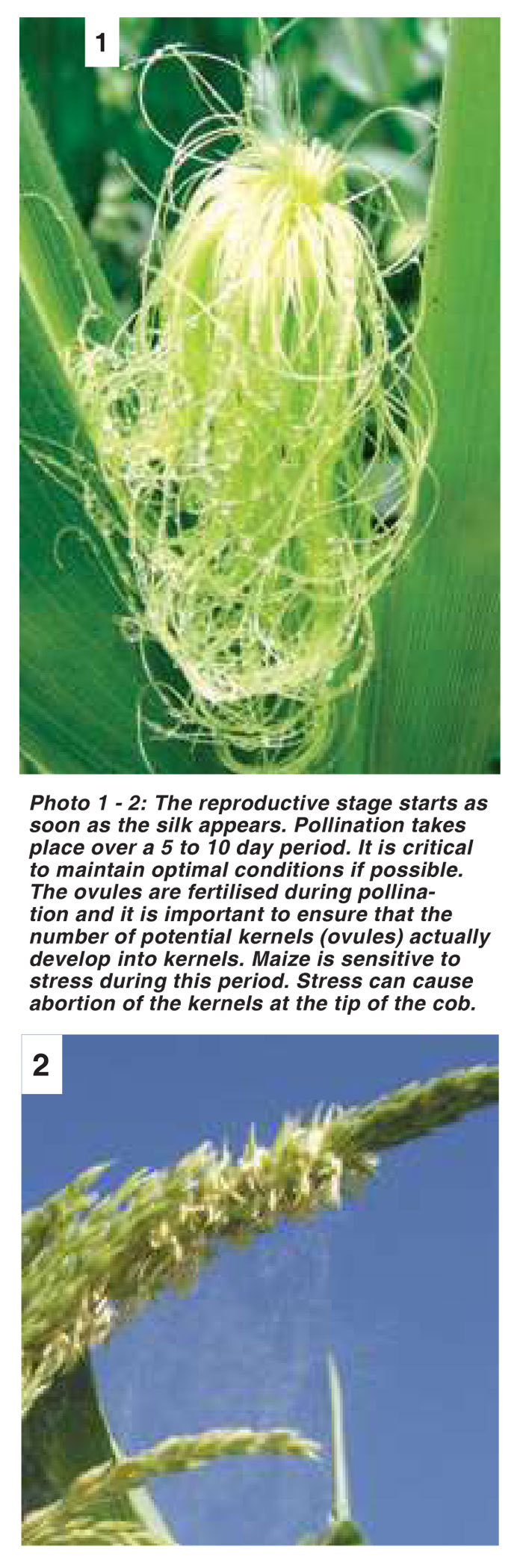March 2017
 When we look at a maize field we are actually seeing thousands of efficient plant “factories” that produce energy through photosynthesis. The raw materials for the factories (plants) are water and mineral nutrients from the soil and carbon dioxide and oxygen from the atmosphere.
When we look at a maize field we are actually seeing thousands of efficient plant “factories” that produce energy through photosynthesis. The raw materials for the factories (plants) are water and mineral nutrients from the soil and carbon dioxide and oxygen from the atmosphere.
The plants use sunlight as an energy source to produce carbohydrates, protein and oil that are stored as grain. The maize plant is largely dependent on nature for its growth, development and yield. However, the farmer can manipulate the environment through management of aspects such as hybrid choice, tillage, crop rotation, fertilisation, irrigation and pest control. A farmer who understands the growth and development of maize will apply the right production practice at the right time to achieve higher yields and profits.
The growth stages of a plant can be divided into different development stages. With the first stage called the vegetative stage, where the plant develops the “factory” that is going to produce the raw material to be stored as grain.
In the vegetative stage the plant used all the energy to produce the leaves and stalks – the “factory”. When the maize plant is fully developed it will go over into the reproductive stage and the leaves will produce sugar to be converted and stored as carbohydrates, protein and oil in the grain.
A typical characteristic of the first stages of reproductive growth is when the silk appears at the tip of the ear. The silk usually grows for three to four days while pollen shedding takes place mainly in the mornings for a period of about seven days. Drought stress in this stage will reduce the time of pollen shedding and delay silk development, while cool, moist conditions are responsible for an increase in silk and pollen production. Tillers will shed pollen seven to ten days later than the main plant, which could be advantageous in some dry seasons.
Dryland production and pollination period
The growth stage of the maize plant at the time of pollen shedding and silk development in dryland production is of utmost importance. In the western production areas of the country it is the determining factor for the best planting time for the biggest portion of the crop. During pollination the pollen lands on the sticky silks, germinates and grows down to the egg nucleus on the cob where fertilisation takes place. The whole process takes about 24 hours which makes it one of the quickest growth processes in nature.
Management hints
The most important management tools are the choice of planting date and plant populations under dryland production, especially in the western production areas of South Africa. These choices are linked to the long-term climatic conditions of the area. This is the most critical time in the development of the maize plant, as the moisture requirement of the plant is at its highest level and damage due to drought stress the most severe. From the above it is imperative that long-term rainfall records are studied carefully to determine the peak rainfall periods as well as the obvious mid-summer drought periods (if applicable) that need to be avoided to ensure a good crop.
From the above information it has been proved that the peak planting date for the Western production regions are after 20 November for the best results. Hybrid choice is another tool that can assist in reducing risk. The yield of prolific-eared hybrids (two or more ears per plant) is more stable under stress conditions, although non-prolific hybrids (strongly single-eared) that are available often will out yield prolific hybrids under nonstress conditions. Hybrids that have proved themselves over the years under dryland conditions as well as at low plant populations during good and bad seasons must receive first choice. Prolific hybrids play a vital role in hybrid choice in the Western production regions.
In the Eastern Highveld the primary factor determining plant date is the number of heat units required by the crop which means that the bulk of the planting should take place in October for best results.
With an irrigated crop it is especially important to take note of the critical time, two weeks before and two weeks after silk development when enough moisture should be available to the plant.
Article submitted by Peet van der Walt, Advertising Manager, PANNAR SEED (PTY) LTD South Africa. For more information, send an email to peet.vanderwalt@pannar.co.za.
Publication: March 2017
Section: Pula/Imvula